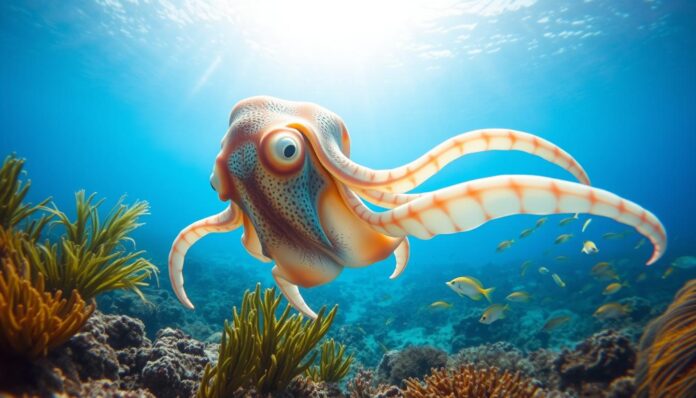Imagine seeing a marine creature change color and texture in a blink of an eye. The Giant Australian Cuttlefish (Sepia apama) can do this, making diving with them a unique adventure. It’s a favorite among marine lovers from all over.
In Spencer Gulf, South Australia, thousands of these amazing creatures meet every year. This creates a stunning underwater show. From June to July, divers get to see a special event that shows nature’s incredible skills.
Diving with cuttlefish is more than just seeing something beautiful. These smart sea creatures are curious and might follow you for up to 15 minutes. The Upper Spencer Gulf Marine Park is the best place for underwater photos, letting you capture these magical moments.
Key Takeaways – Diving with Cuttlefish
- Cuttlefish are masters of camouflage with incredible color-changing abilities
- Spencer Gulf offers the world’s largest known cuttlefish gathering
- Peak breeding season occurs in June and July
- Divers can interact with friendly and curious cuttlefish
- Underwater photography opportunities are exceptional
Overview of Cuttlefish and Their Habitat
Dive into the fascinating world of marine life encounters with cuttlefish. These extraordinary creatures captivate both marine enthusiasts and scientists. They live in diverse habitats across the world’s oceans, showing us the underwater world’s complexity.
What Are Cuttlefish?
Cuttlefish are intelligent marine animals, part of the class Cephalopoda. They are related to octopuses and squid. With over 120 species worldwide, they show a wide range of marine life diversity. They can grow from 6 to 20 inches long and live deep, almost 2,000 feet down.
Key Characteristics of Cuttlefish
- Possess 3 unique hearts for efficient blood circulation
- Have 10 appendages: 8 arms and 2 long tentacles
- Can display at least 13 body pattern types
- Live for 1-2 years with rapid growth rates
Where to Find Cuttlefish in the Ocean
Cuttlefish live in many parts of the ocean, from tropical waters to temperate coasts. Their ability to adapt makes them thrive in different ecosystems. This means you can find them in many places, making marine life encounters possible.
| Region | Typical Cuttlefish Species | Depth Range |
|---|---|---|
| Southern Australia | Giant Australian Cuttlefish | 0-200 meters |
| Mediterranean Sea | Common Cuttlefish | 10-200 meters |
| Indo-Pacific | Broadclub Cuttlefish | 1-100 meters |
“Cuttlefish are living proof that nature’s creativity knows no bounds.” – Marine Biologist Dr. Elena Rodriguez
Learning about these amazing creatures opens up incredible underwater experiences. It also deepens our appreciation for marine biodiversity.
Why Scuba Dive with Cuttlefish?
Diving with cuttlefish is an amazing underwater adventure. It attracts both marine lovers and scientists. These encounters with cuttlefish give us a peek into one of nature’s most intriguing creatures.
Unique Behaviors of Cuttlefish
Cuttlefish show incredible intelligence and adaptability. They have big brains for their size, rivaling those of pigeons and mice. This makes them stand out among sea creatures.
- Can learn multiple conditional rules simultaneously
- Possess exceptional problem-solving skills
- Demonstrate complex communication strategies
Color Changing Abilities
Cuttlefish can change color in seconds. They have about 20 million pigment cells for this. This ability helps them in many ways:
- Camouflage for protection
- Communication with other cuttlefish
- Hunting and predator avoidance
*”Cuttlefish are living art galleries, painting themselves with colors and patterns that defy imagination.”*
Importance in Marine Ecosystems
Cuttlefish are key to marine life. Their unique features, like three hearts, make them interesting for scientists. They can live up to two years and have been around for millions of years.
| Cuttlefish Characteristic | Scientific Detail |
|---|---|
| Depth Range | Up to 600 meters |
| Reproductive Strategy | Unique mating behaviors |
| Intelligence Level | High brain-to-body mass ratio |
Diving with cuttlefish is a unique chance to see these sea wonders up close. It’s a must for anyone who loves exploring the ocean.
Best Locations for Cuttlefish Diving
Exploring the underwater world of cuttlefish requires knowing the most spectacular dive sites with cuttlefish. Marine enthusiasts and underwater photographers seek out unique locations. These offer extraordinary cuttlefish watching experiences across different global regions.
Top Global Destinations for Cuttlefish Encounters
Divers can discover remarkable cuttlefish populations in several marine environments. The most exceptional locations span multiple continents:
Asia:
- Indonesia – The waters of Indonesia offer incredible diving opportunities to encounter cuttlefish. Locations such as Bali, Komodo National Park, and the Lembeh Strait are known for their rich biodiversity and the presence of numerous cuttlefish species.
- Philippines – With its warm waters and thriving marine life, the Philippines is a paradise for divers. Destinations like Anilao, Moalboal, and Puerto Galera are renowned for their diverse marine ecosystems, including encounters with cuttlefish.
- Maldives – The Maldives, with its crystal-clear waters and abundant marine life, provides an ideal setting for diving with cuttlefish. Explore the atolls and encounter different species of cuttlefish, along with vibrant coral reefs and pelagic marine creatures.
- Egypt – The Red Sea in Egypt offers outstanding diving experiences, including encounters with cuttlefish. Destinations such as Sharm El Sheikh, Dahab, and Marsa Alam are popular for their diverse marine life, including the flamboyant cuttlefish.
- South Africa – South Africa boasts remarkable dive sites along its coastlines. Locations like Sodwana Bay, Aliwal Shoal, and the Protea Banks are known for their vibrant underwater ecosystems, offering opportunities to observe cuttlefish and other fascinating marine species.
- Bonaire – Bonaire in the Dutch Caribbean is a renowned destination for diving enthusiasts. Its pristine reefs and marine parks, such as Bonaire National Marine Park, provide the chance to encounter cuttlefish amidst the colorful coral formations.
- Cayman Islands – The Cayman Islands offer world-class diving experiences in the Caribbean. Explore sites like Grand Cayman, Little Cayman, and Cayman Brac, where encounters with cuttlefish can be complemented by encounters with turtles, stingrays, and an abundance of marine life.
- Belize – Belize’s barrier reef, a UNESCO World Heritage Site, is a haven for divers. Locations such as Ambergris Caye and the Blue Hole are popular for their stunning underwater landscapes and encounters with various species of cuttlefish.
- Costa Rica – Costa Rica, with its Pacific and Caribbean coastlines, presents diverse diving opportunities. Destinations like Cocos Island, Guanacaste, and Manuel Antonio are known for their rich marine biodiversity, providing chances to encounter cuttlefish and other captivating marine species.
- Greece – The waters surrounding Greece offer remarkable diving experiences. Islands such as Zakynthos, Crete, and Santorini provide opportunities to encounter Mediterranean cuttlefish, explore fascinating underwater caves, and discover ancient shipwrecks.
- Spain – The Mediterranean coast of Spain is a treasure trove for divers. Destinations like the Costa Brava, the Balearic Islands, and the Canary Islands offer encounters with cuttlefish, along with vibrant coral reefs and a diverse range of marine life.
- Australia – Australia’s Great Barrier Reef is a world-renowned diving destination, providing opportunities to encounter various species of cuttlefish. Locations like Cairns, Port Douglas, and the Whitsunday Islands offer unforgettable underwater experiences amidst one of the world’s most iconic natural wonders.
- Fiji – Fiji’s warm waters and thriving reefs make it an excellent destination for diving with cuttlefish. Explore sites like the Somosomo Strait, the Bligh Water, and the Kadavu Island group to witness these fascinating creatures in their natural habitat.
- Mexico – Mexico’s coastal regions offer diverse diving opportunities. Destinations like Cozumel, Riviera Maya, and the Socorro Islands present encounters with cuttlefish amidst breathtaking coral formations and encounters with other marine species, including turtles and rays.
- United States – The United States boasts a variety of dive sites along its coastlines. Locations such as the Florida Keys, California’s Channel Islands, and Hawaii provide memorable encounters with cuttlefish and opportunities to explore unique marine environments.
- Galapagos Islands – The Galapagos Islands, located off the coast of Ecuador, are a dream destination for divers. Explore the incredible marine biodiversity of this UNESCO World Heritage Site, encountering cuttlefish, sea lions, marine iguanas, and other unique species.
- Brazil – Brazil offers exceptional diving experiences along its extensive coastline. Locations like Fernando de Noronha, Abrolhos Marine National Park, and Ilha Grande provide encounters with cuttlefish amidst vibrant coral reefs and an abundance of marine life.
When planning your diving adventure, consider the best time to visit each destination, taking into account factors such as water temperature, visibility, and specific cuttlefish breeding seasons. Local dive operators and guides can provide valuable insights and help maximize your chances of encountering these fascinating cephalopods.
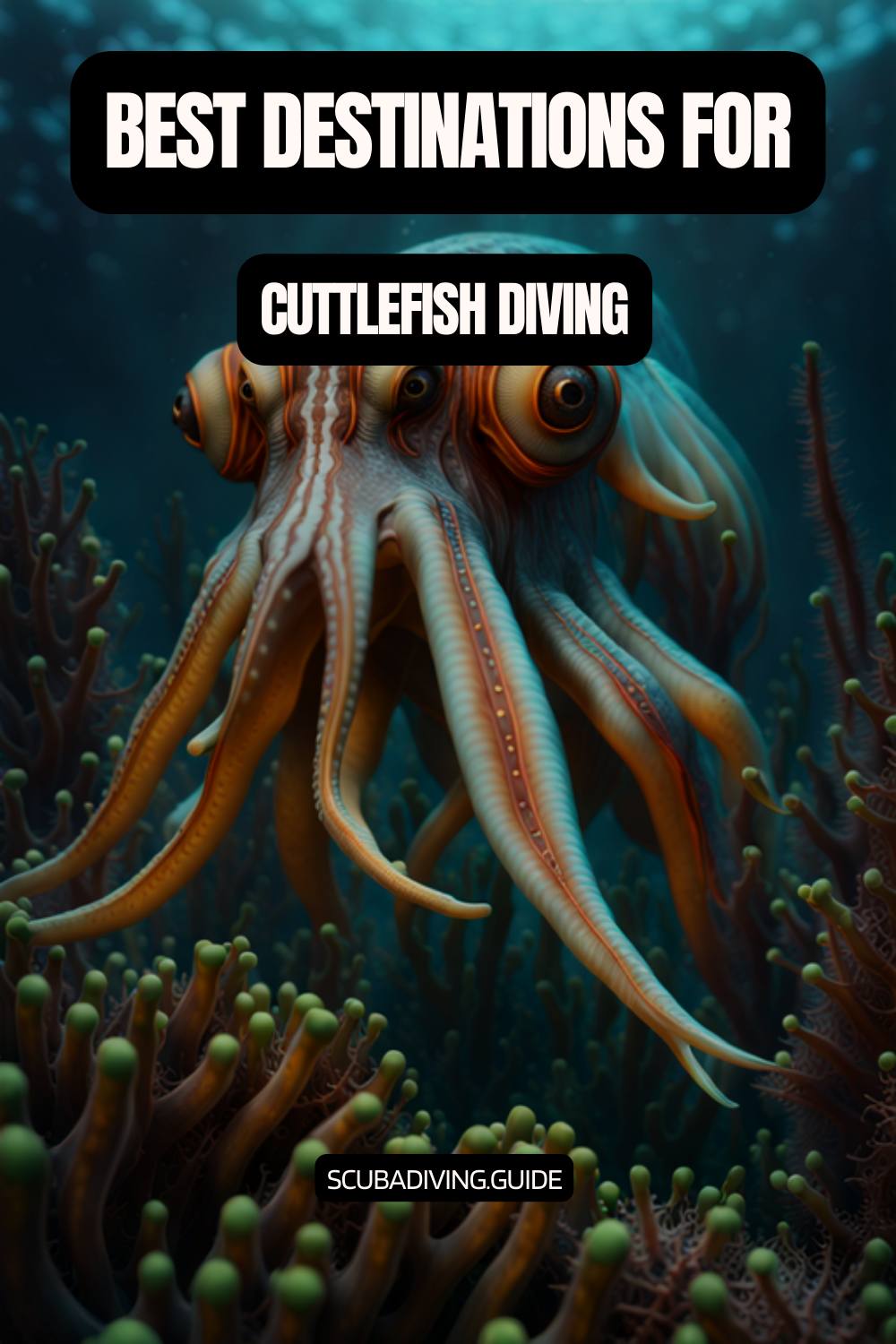
Seasonal Considerations for Cuttlefish Diving
Timing plays a key role in successful cuttlefish watching. The Giant Australian Cuttlefish offers a spectacular natural phenomenon. This happens during winter months from May through August in South Australia’s Upper Spencer Gulf.
| Location | Peak Season | Water Temperature |
|---|---|---|
| Whyalla, Australia | May-August | 57°F |
| Point Lowly | Winter Months | Cool Temperate |
Accessibility and Diving Conditions
Most cuttlefish dive sites accommodate various skill levels. The typical depth range of six to 36 feet makes these locations ideal. They are perfect for new divers, snorkelers, and experienced underwater explorers alike.
“Witnessing thousands of cuttlefish gathering is like observing an underwater ballet of color and movement.”
Understanding local marine conditions, water visibility, and seasonal migrations will enhance your dive sites with cuttlefish experience. Prepare for an unforgettable underwater adventure!
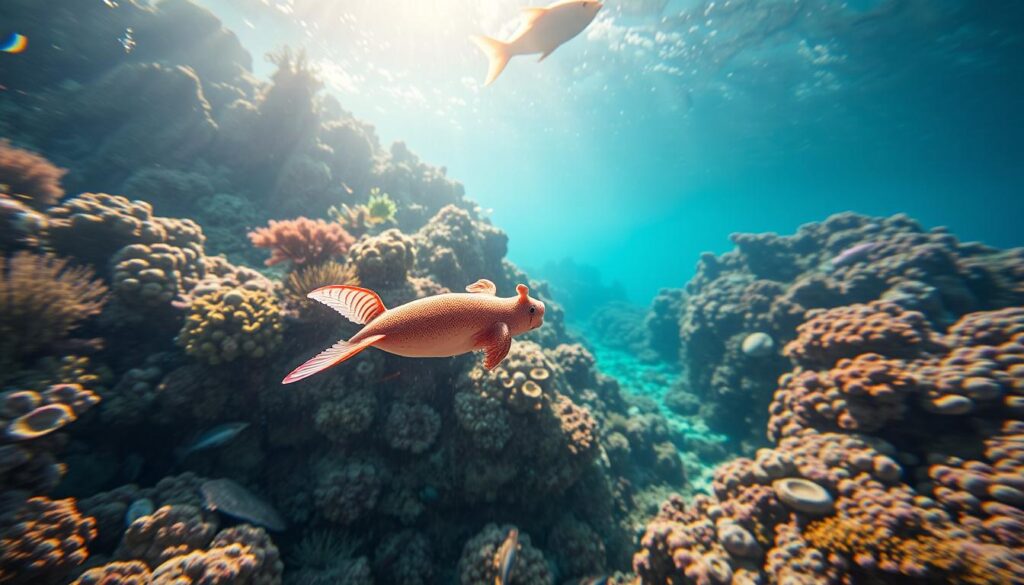
Equipment Needed for Cuttlefish Diving
Getting ready for an underwater photography trip with cuttlefish needs careful planning and the right gear. Scuba diving with cuttlefish requires special equipment for safety and a great experience in their home.
Essential Scuba Gear for Marine Exploration
Your gear list is key when diving in cuttlefish areas. Cold water means you need specific gear to stay warm and safe.
- Full-length 5mm or 7mm wetsuit
- Thermal hood
- Neoprene gloves
- Waterproof boots
- Buoyancy compensation device (BCD)
- Reliable underwater breathing apparatus
Underwater Cameras for Capturing Cuttlefish Magic
Photographing cuttlefish underwater needs special camera gear to capture their amazing color changes.
| Camera Type | Recommended Features | Ideal Use |
|---|---|---|
| Compact Underwater Camera | Waterproof to 30 meters, wide-angle lens | Beginner photographers |
| Mirrorless Camera | Interchangeable lenses, high ISO performance | Professional underwater photography |
| Action Camera | 4K video, compact design | Dynamic underwater shooting |
Safety Equipment and Precautions
Diving with cuttlefish needs thorough safety plans. Always carry emergency signals, backup air, and keep your diving certifications up to date.
“Preparation is the key to a safe and memorable underwater adventure.” – Marine Photography Expert
About 60% of professional scuba divers say marine wildlife encounters make their dives better. Quality equipment and knowing cuttlefish habitats help you get the best photos.
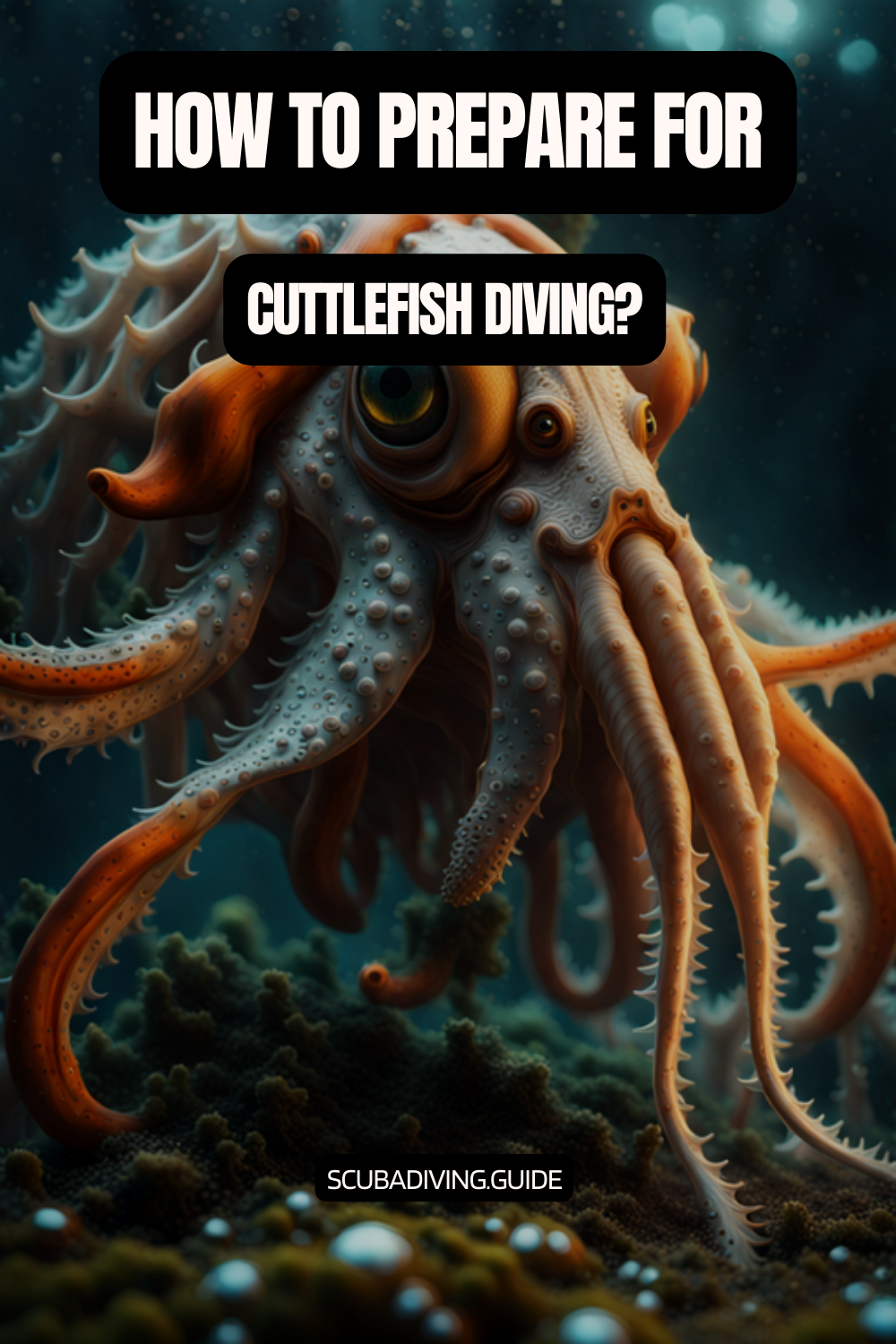
How to Approach Cuttlefish While Diving
Diving with cuttlefish is an amazing experience. It requires careful and respectful interaction. These creatures are known for their complex behavior, making each dive unique.
Best Practices for Marine Encounters
When you dive and meet cuttlefish, follow these important tips:
- Maintain a calm and slow movement to avoid startling the creature
- Keep a distance of at least 3-4 feet to respect their personal space
- Avoid sudden gestures or loud underwater sounds
- Use neutral buoyancy techniques to minimize environmental disturbance
Understanding Cuttlefish Behavior
Cuttlefish are very smart and have great communication skills. Their ability to change colors rapidly lets them show emotions, hide, and talk to other sea creatures.
“Observing cuttlefish is like watching a living, breathing light show underwater.” – Marine Biologist
Respecting Their Natural Environment
Divers are key in protecting marine life. When you meet cuttlefish, remember these important rules:
- Never touch or attempt to handle cuttlefish
- Do not disturb their habitat or feeding grounds
- Use environmentally friendly diving practices
- Share your observations to promote marine awareness
Every day, divers at places like Wakatobi learn new things. They can enjoy these amazing creatures while keeping them safe and protected.
Cuttlefish Diving Tours and Experiences
Dive into the fascinating world of marine encounters with specialized cuttlefish diving tours. These tours offer an unparalleled eco-tourism experience. Scuba diving with cuttlefish provides an extraordinary opportunity to witness these incredible marine creatures in their natural habitat.
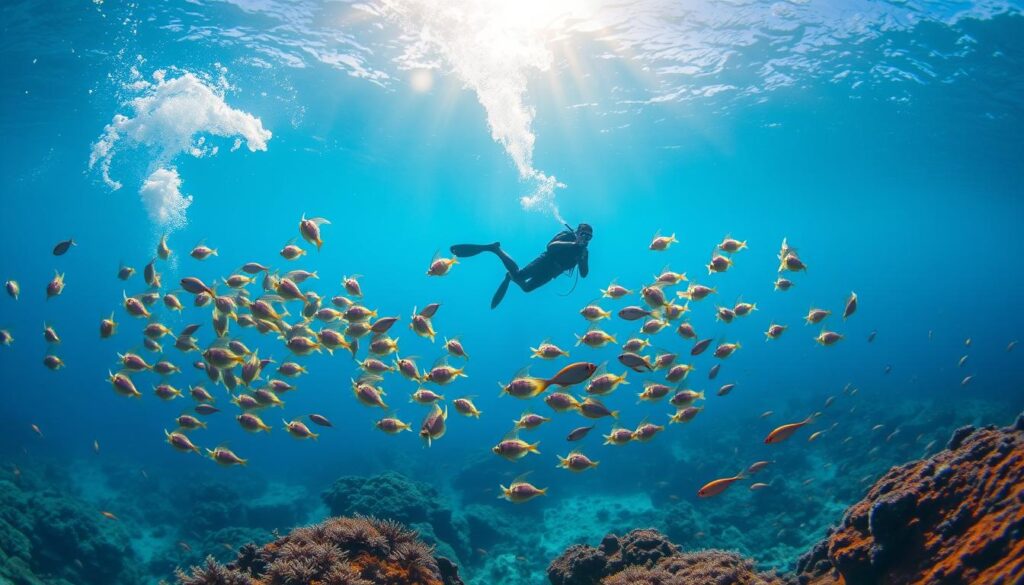
Recommended Tour Companies
Several expert tour operators specialize in unique cuttlefish diving experiences. The best companies focus on responsible marine exploration and eco-tourism with cuttlefish. Top recommendations include:
- Spencer Gulf Marine Expeditions
- Whyalla Underwater Adventures
- Point Lowly Diving Experiences
What to Expect on a Guided Dive
A typical cuttlefish diving tour offers remarkable underwater experiences. Participants can expect:
- Pre-dive safety briefing
- Expert guidance from marine biologists
- Close encounters with Giant Australian Cuttlefish
- Professional underwater photography support
“Watching cuttlefish perform their mating dance is like witnessing an underwater ballet of nature’s most fascinating creatures.” – Marine Biologist
Costs and Packages Available
Diving tour packages vary based on duration and experience level. Prices typically range from $150 to $350 per person. Most tours include equipment rental, professional guidance, and marine park access fees.
The annual cuttlefish gathering from May to August offers the most spectacular diving opportunities. Thousands of cuttlefish gather in the Upper Spencer Gulf Marine Park.
Environmental Impact on Cuttlefish Populations
The world of cuttlefish habitats is facing big challenges today. These amazing creatures are under a lot of pressure. This pressure threatens their survival and future.
Threats Facing Cuttlefish
Cuttlefish are facing many big challenges:
- Overfishing is reducing their numbers
- Habitat destruction of coral reefs
- Climate change is changing their homes
- Plastic pollution is polluting their space
“Less than one percent of high seas are currently highly protected, highlighting the urgent need for marine conservation efforts.”
Conservation Efforts for Their Protection
Eco-tourism with cuttlefish is helping raise awareness and support conservation. Many important projects are underway:
- Creating marine protected areas
- Setting strict fishing rules
- Studying their populations
- Encouraging sustainable marine practices
How Divers Can Help
Divers are key in protecting cuttlefish habitats. They can do this by diving responsibly:
- Reducing underwater disturbances
- Joining marine conservation efforts
- Supporting local marine protection
- Spreading the word about cuttlefish conservation
By protecting these incredible creatures, we can ensure they survive for generations to come.
Capturing Memorable Moments Underwater
Underwater photography turns watching cuttlefish into a story you’ll never forget. It needs skill, patience, and the right tools. Professional photographers know this well.
Photography Tips for Cuttlefish
Getting great shots of cuttlefish underwater is a challenge. Here are some key tips:
- Use a camera with manual white balance settings
- Choose wide-angle lenses for full marine views
- Learn about cuttlefish behavior to get the best shots
- Keep your movements steady underwater
Filming Techniques for Stunning Footage
For amazing cuttlefish videos, you need the right filming tricks. Here’s what pros suggest:
- Stay neutral in the water for smooth video
- Use continuous autofocus
- Choose cameras that work well in low light
- Get quality underwater video housings
Sharing Your Cuttlefish Adventure
Today’s underwater photographers share their adventures online. They use different platforms to tell their stories. This lets fans see their cuttlefish watching adventures through:
| Platform | Audience Reach | Content Type |
|---|---|---|
| Global Photography Community | Visual Storytelling | |
| YouTube | Video Enthuasiasts | Immersive Documentaries |
| Conservation Websites | Scientific Community | Educational Content |
“Every underwater photograph tells a story of marine wonder and ecological complexity.” – Marine Photography Expert
Remember, underwater photography is about patience, respect for marine life, and capturing fleeting moments of extraordinary beauty.
Frequently Asked Questions About Cuttlefish Diving
Diving with cuttlefish is a unique chance for marine lovers to see one of the sea’s most interesting animals. Our guide answers common questions about diving with Cuttlefish and meeting cephalopods.
Do I Need Special Training?
Cuttlefish diving needs some special knowledge, but it’s open to most intermediate divers. To get ready, you should:
- Have an advanced open water certification
- Know how to control your buoyancy
- Understand how to interact with marine wildlife
- Be familiar with underwater photography
When is the Best Time to Dive?
The best time to dive with cuttlefish varies by location. For the Upper Spencer Gulf Marine Park, the best months are May to August. The peak breeding time is in June and July.
Are Cuttlefish Dangerous to Divers?
Cuttlefish are usually calm during encounters. They are smart and mostly curious, not aggressive. Important safety tips include:
- Keep a respectful distance
- Avoid sudden movements
- Don’t try to touch or provoke them
- Watch their natural behaviors
*”Cuttlefish are more likely to fascinate you than frighten you during underwater interactions.”*
Knowing how these marine animals behave will make your dive safe and unforgettable.
Common Marine Species Found Alongside Cuttlefish
Diving with cuttlefish provides a unique opportunity to explore vibrant and diverse underwater ecosystems that are home to a variety of marine species. While encountering cuttlefish is a thrilling experience in itself, these remarkable creatures often share their habitat with other fascinating organisms. Here are some common marine species you may encounter while diving with cuttlefish:
- Reef Fish: Cuttlefish are frequently found in coral reef environments, where they coexist with a myriad of colorful reef fish. From vibrant angelfish and butterflyfish to darting clownfish and sleek parrotfish, the reef is teeming with life. Observing the symbiotic relationships, intricate behaviors, and diverse species interactions within the reef ecosystem adds to the richness of the dive experience.
- Octopuses: As close relatives, octopuses often share habitats with cuttlefish. These intelligent and elusive creatures possess remarkable camouflaging abilities and are known for their problem-solving skills. Spotting an octopus nestled within the coral or hiding in a crevice is a thrilling sight during a dive with cuttlefish.
- Seahorses: Seahorses are enchanting creatures often found in seagrass beds, coral reefs, or other shallow marine environments. Their unique appearance and delicate movements make them fascinating subjects for underwater photography. Exploring their habitats alongside cuttlefish provides a glimpse into the intricate balance of life in these ecosystems.
- Moray Eels: Moray eels, with their elongated bodies and menacing jaws, are commonly found hiding in crevices or coral formations. These elusive predators play a vital role in maintaining the balance of the marine ecosystem. Spotting a moray eel lurking in its lair is an exciting encounter that adds an element of intrigue to the dive.
- Turtles: Cuttlefish and turtles often share similar foraging grounds and reef habitats. The sight of a graceful sea turtle gliding through the water is a true delight for divers. Observing these gentle giants as they feed or gracefully swim past creates lasting memories of the underwater realm.
- Nudibranchs: Nudibranchs, also known as sea slugs, exhibit an array of vibrant colors and intricate patterns. These captivating creatures, often found on reefs and in seagrass meadows, come in various shapes and sizes. The opportunity to discover these fascinating organisms alongside cuttlefish adds to the visual richness and diversity of the underwater environment.
- Stingrays: Stingrays gracefully glide across sandy bottoms and coral reefs, their flattened bodies blending seamlessly with the surroundings. Observing their gentle movements and witnessing their feeding behavior is a remarkable experience that complements the encounter with cuttlefish.
- Crustaceans: Lobsters, crabs, and shrimp are among the many crustaceans that can be encountered during a dive with cuttlefish. From the cryptic patterns of a camouflaged decorator crab to the impressive size of a spiny lobster, these creatures add diversity and intrigue to the underwater landscape.
Encountering these marine species alongside cuttlefish provides a comprehensive understanding of the interconnectedness and biodiversity of the underwater world. As you explore the depths, take the time to appreciate the intricate relationships and behaviors of these cohabiting organisms, enhancing your appreciation for the fragile and intricate balance of marine ecosystems.
Conclusion: Join the Adventure with Cuttlefish
Scuba diving with Cuttlefish is an amazing experience that turns ordinary dives into unforgettable adventures. The waters of Whyalla are home to up to 250,000 Giant Cuttlefish. They gather here from May to August, during their breeding season.
Summary of the Experience
These marine wonders can grow up to 1.5 meters long. They show off their color-changing skills and complex mating rituals. Divers get to see their social behaviors, with males vying for female attention in underwater territories.
Encouragement to Dive Responsibly
It’s important to dive responsibly in cuttlefish habitats. Keep a safe distance and wear warm clothes, as the water is chilly. This helps protect these amazing creatures and their homes.
Final Thoughts on Cuttlefish Diving
Scuba diving with Cuttlefish is an experience for everyone. It’s a chance to connect with these smart creatures and capture their unique behaviors. It also helps spread the word about marine conservation.
FAQ – Diving with Cuttlefish
Do I need special training to dive with cuttlefish?
You don’t need special training, but an advanced open water certification is helpful. Experience with underwater wildlife is also good. Some dive operators offer workshops on how to interact with cuttlefish responsibly.
What time of year is best for cuttlefish diving?
The best time depends on where you are. In South Australia, dive from May to August for the breeding season. In Indonesia and Malaysia, you can dive with cuttlefish all year, with peak times varying by site.
Are cuttlefish dangerous to divers?
Cuttlefish are not dangerous to humans. They are curious and intelligent, often watching divers without aggression. Their powerful beaks are more for changing colors than attacking.
What equipment do I need for cuttlefish photography?
For great photos, use a camera with manual settings and a wide-angle or macro lens. External lighting is also key. A camera that works well in low light and captures color changes is best. Waterproof housing and color-correcting filters can improve your shots.
How close can I get to cuttlefish while diving?
Stay at least 3-4 feet away. Getting too close stresses them and changes their behavior. Move slowly and let them come to you if they’re interested.
What depth range do cuttlefish typically inhabit?
Cuttlefish live between 10 to 100 meters deep. Different species prefer different depths, from shallow reefs to deeper waters.
Can I interact with cuttlefish during night dives?
Night dives are great for seeing cuttlefish. They’re active at night, showing off their bioluminescence and color changes. But, you’ll need night diving certification and gear for safe viewing.
How long do cuttlefish live?
Most cuttlefish live 1-2 years. They grow up fast, mature early, and complete their life cycle quickly. Some may live a bit longer, depending on their environment.
Are there conservation efforts to protect cuttlefish?
Yes, many groups are working to save cuttlefish habitats. They’re creating protected areas, studying populations, and spreading the word about these important creatures.
What’s the best way to learn about cuttlefish behavior before diving?
Watch marine documentaries and read about cephalopod behavior. Talk to marine biologists or dive instructors who know about cuttlefish. This will help you prepare for your dive.
